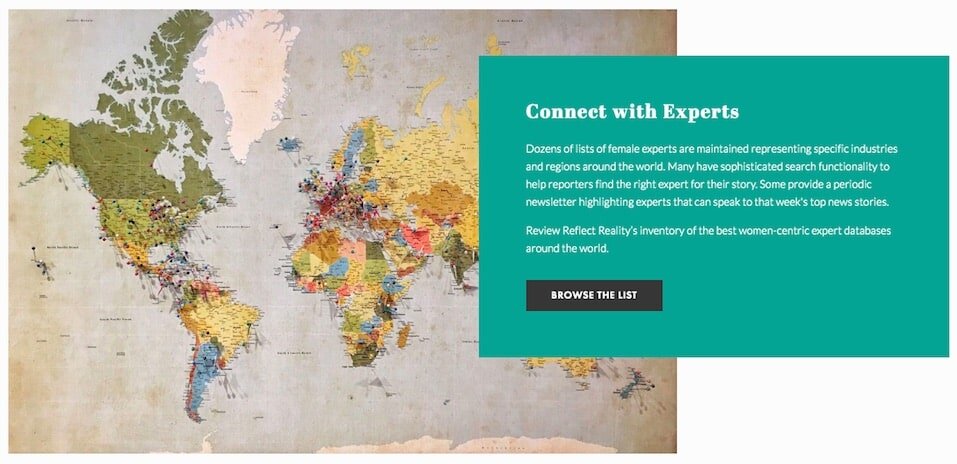Cultivating Sources
Once newsrooms and reporters are motivated to increase the number of women as sources in their news stories, how do they go about finding and cultivating more female sources? In many cases, it simply means taking the extra effort to sidestep an existing go-to source to find a qualified source who is also a woman. In other cases, it’s not that simple. While in many places in the world women are on par or outperforming men in academia, and rising in the ranks in the business world, identifying interview-ready female sources and spokespersons remains a challenge even for highly motivated reporters. Presented here are some strategies that may help.
1) Search Existing Expert Databases
Search for female experts in public databases. Dozens of lists of female experts are maintained representing specific industries and regions around the world. Many have sophisticated search functionality to help reporters find the right expert for their story. Some provide a periodic newsletter highlighting experts that can speak to that week's top news stories.
Review Reflect Reality’s inventory of the best women-centric expert databases around the world.
2) Build an Expert Database
Also consider building a custom database or list of female sources for your newsroom or for a particularly challenging news beat. Ask reporters to add to it as they find new female sources.
Learn how an online database of Thai female experts was created in Bangkok. Reflect Reality spoke with Misako Ito, who managed the development of UNESCO’s Women Make the News Thailand, an online database of female experts for journalists.
“We are building a separate database of women experts globally and put it into a database with search functionality, including detail about each expert’s expertise. ”
3) Host an Open House
Newsrooms and journalists note that new sources often express a level of discomfort being interviewed, particularly on TV. A successful approach for the BBC, Bloomberg, and others is hosting events for potential sources to familiarize them with the newsroom and interview process.
Members of Northern Power Women, an association of women in business, gather for an Open Day at the BBC’s MediaCityUK studios in Salford, June 17th, 2019. Photo credit: BBC
4) Appeal to the Communication Departments
A key strategy for sourcing women in the news is to reach out to an organization’s public relations department and ask for women who are qualified to speak to the area of interest. You can also help educate staff from the organizations you go to for sources about the importance of fielding female spokespersons.
5) Adopt an Intersectional Perspective
It’s important to remember that when women’s voices are included as sources, they often represent women of more privileged groups. To ensure you are also sourcing the voices of women from diverse backgrounds, Giulia Dessi at the Media Diversity Institute encourages newsrooms and journalists to take an intersectional approach when planning stories and sources.
Members of Northern Power Women, an association of women in business, gather for an Open Day at the BBC’s MediaCityUK studios in Salford, June 17th, 2019. Photo credit: BBC
Try an intersectional approach
By Giulia Dessì, Media Diversity Institute
Efforts to increase gender parity in the media often focus on strategies to increase the presence of women. But considering that the experience of women is shaped profoundly by their other social identities such as race, class, and sexuality, could the term “women”, when used uncritically, obscure a range of different subject positions? To avoid this, one suggestion is to adopt an intersectional perspective, which pays attention to the ways women’s lives are shaped by overlapping identities. This point of view challenges the assumption of “sameness of experience” and opens new approaches to making women’s voices heard.
Scholar Kimberlé Crenshaw proposed the concept of “intersectionality” in 1989. Crenshaw defines intersectionality as “a lens through which you can see where power comes and collides, where it interlocks and intersects.” She says: “It’s not simply that there’s a race problem here, a gender problem here, and a class or LBGTQ problem there. Many times that framework erases what happens to people who are subject to all of these things.” In other words, the oppression of women is not homogeneous and immutable, but it shifts in relation to other social categories. For example, a report by The Women’s Media Center, reveals how women of color typically face different forms of discrimination compared to white women, as well as specific, systemic obstacles that deter and prevent their representation in media.
Beyond simply seeking out women to source in news stories, taking an intersectional approach to news gathering can be more transformative in terms of fostering diversity. In some cases, where journalism supports social movements, it also helps to rethink the principle of objectivity in media. For example, taking an intersectional approach could mean developing stories around socio-political projects, in which activists from marginalized groups work as journalists to provide a more nuanced and embedded perspective of an issue. Alternatively, media practitioners who are not activists could co-produce content and cultivate horizontal relationships with sources. Intersectionality is a valuable lens that makes visible the range of different subject positions that the term “women” encompasses and provides the foundations for more inclusive forms of journalism.
6) Collaborate with Women’s Professional Associations
To build out your expert list, reach out to professional associations. Explain your goal. They are likely aware of the lack of women's voice in their industry and will be happy to make introductions to their members.
As part of their efforts to cultivate a database of female sources, Bloomberg worked closely with the Hawthorne Club, an association for women executives in the energy industry. The Toronto Star is collaborating with She Innovates Alberta, an initiative to support women innovators and entrepreneurs.
7) Plan ahead
Get in the habit of cultivating sources ahead of time, so you have a list of potential options once the news cycle for that topic heats up. For instance, dedicate some time to identifying potential female sources ahead of an election period, to speak on specific hot-button election issues.
8) Leverage the Social Media Department
Task social media staff to identify potential news sources. As they post content to relevant social media channels and communities, they can also look for leads. This has proven successful for the Toronto Star.
See our Q&A with Evelyn Kwong, Social and Audience Lead at the Toronto Star.
BBC Business Unit's Open Day, International Women's Day,March 8th, 2019. The BBC's 50:50 Project helps organize Open Days for potential women contributors to experience the BBC and studio environment, and build their confidence, should they be invited to participate on-air. Photo credit: BBC















